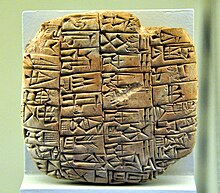Shuruppak
Shuruppak (Sumerian: 𒋢𒆳𒊒𒆠 ŠuruppagKI, SU.KUR.RUki, "the healing place"), modern Tell Fara, was an ancient Sumerian city situated about 55 kilometres (35 mi) south of Nippur and 30 kilometers north of ancient Uruk on the banks of the Euphrates in Iraq's Al-Qādisiyyah Governorate.
[3] In later versions of the Epic of Gilgamesh, a man named Utnapishtim, son of Ubara-Tutu, is noted to be king of Shuruppak.
[5] Cuneiform tablets from the Early Dynastic III period show a thriving, military oriented economy with links to cities throughout the region.
[6] It has been proposed that Fara was part of a "hexapolis" with Lagash, Nippur, Uruk, Adab, and Umma, possibly under the leadership of Kish.
One of the tablets found at the site is dated by a year name to the beginning of the reign of Shu-Sin, next to last ruler of Ur III.
[12] A few governors of Shurappak under the Ur III Empire are known from contemporary epigraphic remains, Ku-Nanna, Lugal-hedu, Ur-nigin-gar, and Ur-Ninkura.
A Isin-Larsa cylinder seal and several pottery plaques which may date to early in the second millennium BC were found at the site.
[15] In the 2nd year of Enlil-bani (c. 1860–1837 BC), ruler of Isin, a sage of Nippur is recorded as leaving an herbal medicine at Shurappak.
The report of the 1930s excavation mentions a layer of flood deposits at the end of the Jemdet Nasr period at Shuruppak.
Shuruppak in Mesopotamian legend is one of the "antediluvian" cities and the home of King Utnapishtim, who survives the flood by making a boat beforehand.
Schmidt wrote that the flood story of the Bible, [17]seems to be based on a very real event or a series of such, as suggested by the existence at Ur, at Kish, and now at Fara, of inundation deposits, which accumulated on top of human inhabitation.
[17] It was first excavated between 1902 and 1903 by Walter Andrae, Robert Koldewey and Friedrich Delitzsch of the German Oriental Society for eight months.
[22] About a thousand Early Dynastic clay sealings and fragments (used to secure doors and containers) were also found.
[25] In March and April 1931, a joint team of the American Schools of Oriental Research and the University of Pennsylvania excavated Shuruppak for a further six week season, with Erich Schmidt as director and with epigraphist Samuel Noah Kramer being prompted by reports of illicit excavations in the area.
[30] The researchers found thousands of robber holes left by looters which had disturbed surface in many places, with the top several meters of the main mound destroyed.



